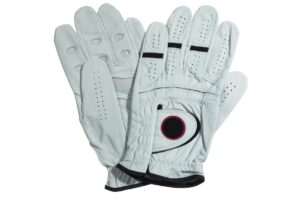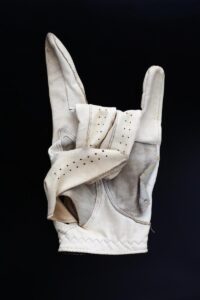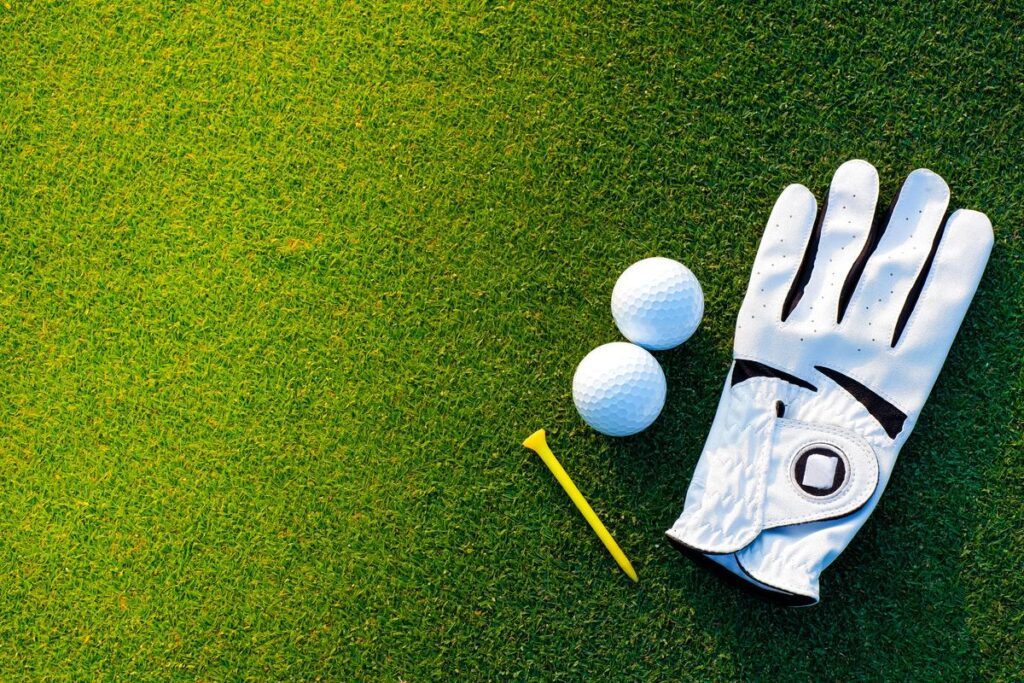Key Takeaways on the Lifespan of Golf Gloves:
- On average, golf gloves can last anywhere from 10 to 20 rounds of golf before showing signs of wear and tear.
- Synthetic leather gloves tend to last longer than genuine leather gloves due to their durability and resistance to moisture.
- Improper storage and exposure to extreme temperatures can accelerate the deterioration of golf gloves.
- Regular cleaning and maintenance can help extend the lifespan of golf gloves.
Golf gloves play a crucial role in a golfer’s game, providing grip, control, and comfort during swings. While many golfers understand the importance of wearing gloves, they often wonder how long these gloves last before needing to be replaced. In this article, we will explore the lifespan of golf gloves and the factors that can affect their durability.
Golf gloves are designed to enhance a golfer’s performance by providing a better grip on the club. By reducing the chances of the club slipping out of the player’s hand, golf gloves help golfers maintain control and accuracy in their swings. Additionally, gloves also offer protection against blisters and calluses, which can negatively impact a golfer’s comfort and performance on the course.
Golf gloves, a staple accessory in the sport, serve a crucial purpose beyond just adding style to your game. Designed to provide a better grip on the club and enhance your performance on the course, these gloves play a significant role in ensuring a steady swing and a precise shot. But what exactly are they and why are they necessary? Let’s delve into the world of golf gloves and uncover their true value.
How Long Do Golf Gloves Last?
If you’re an avid golfer, chances are you rely on a golf glove to enhance your grip and improve your swing. But have you ever wondered how long a golf glove lasts? Well, the answer is not set in stone, as it depends on several factors. Let’s delve into this fascinating topic and discover the life expectancy of a golf glove.
First and foremost, the quality of the glove plays a significant role in its durability. Premium golf gloves, made from high-quality materials such as leather or synthetic blends, tend to last longer than their cheaper counterparts. They can withstand extensive use and retain their shape and functionality.
Furthermore, the frequency of play also affects the longevity of your golf glove. If you hit the course frequently, your glove will naturally wear out faster. Conversely, if you only play occasionally, your glove will likely last longer. It’s essential to examine your glove regularly for signs of wear and tear, such as worn-out fingertips or thinning fabric, as these may compromise its performance.
To help you better understand the average lifespan of a golf glove, here’s a handy table summarizing the estimated longevity based on the frequency of play:
| Frequency of Play | Approximate Lifespan |
|---|---|
| Daily | 2-3 months |
| 2-3 times a week | 4-6 months |
| Once a week | 6-8 months |
| Occasionally | 12+ months |
Keep in mind that this table provides rough estimates and individual experiences may vary. It’s always a good idea to monitor your glove’s condition and replace it when you notice significant signs of deterioration.
In conclusion, while the exact lifespan of a golf glove varies depending on factors like quality, frequency of play, and weather conditions, taking care of your glove and being mindful of its condition can extend its life. So, enjoy your time on the course, and don’t forget to give your trusty golf glove the attention it deserves!
RELATED: Golf Cart Street Driving Laws In California
Materials Used in Golf Gloves

When it comes to golf gloves, the materials used can play a significant role in their durability and longevity. Different types of materials offer different levels of comfort, grip, and durability. Here are some of the most common materials used in golf gloves:
Different Types of Golf Glove Materials
1. Leather: Leather is one of the most popular materials used in golf gloves. It offers a natural feel, excellent grip, and durability. Cabretta leather, in particular, is known for its softness and ability to conform to the shape of the hand, providing a comfortable fit. However, leather gloves may require proper care and maintenance to retain their quality over time.
2. Synthetic Materials: Synthetic materials, such as synthetic leather or microfiber, are also commonly used in golf gloves. These materials are often more affordable than leather and offer good grip and durability. They are also typically more resistant to moisture, which can be an advantage in wet conditions. Synthetic gloves are generally easier to maintain and may have a longer lifespan compared to leather gloves.
3. Hybrid Materials: Some golf gloves combine both leather and synthetic materials to offer the benefits of both. These hybrid gloves may have leather in the palm and fingers for enhanced grip and synthetic materials on the back for added flexibility and breathability.
Durability and Longevity of Different Materials
The durability and longevity of golf gloves can vary depending on the materials used. Here is a general overview of the durability of different materials:
1. Leather: Leather gloves, especially those made with high-quality Cabretta leather, are known for their durability. With proper care and regular cleaning, leather gloves can last for multiple rounds of golf.
2. Synthetic Materials: Synthetic gloves are generally more durable than leather gloves, thanks to their resistance to moisture and wear. They can withstand frequent use and may last longer than leather gloves, especially if they are well-maintained.
3. Hybrid Materials: The durability of hybrid gloves can vary depending on the specific combination of materials used. In general, the leather portion of the glove may wear out faster than the synthetic part. However, hybrid gloves can still offer a good balance of durability and comfort.
It’s important to note that the lifespan of golf gloves can also depend on factors such as frequency of use, climate conditions, and individual hand perspiration. Regularly inspecting your gloves for signs of wear and tear, such as thinning or peeling, can help you determine when it’s time to replace them.
RELATED: What Are The Top Features To Look For In A Golf Cart
Signs of Wear and Tear
Common Signs of a Worn-out Golf Glove

Over time, golf gloves can get worn out due to regular use and exposure to the elements. Here are some common signs that indicate your golf glove may need to be replaced:
1. Visible Holes or Tears: Look for any visible signs of holes or tears in the glove material. These can affect the grip and can lead to discomfort or even blisters while playing.
2. Fading or Discoloration: If your golf glove has lost its original color or appears faded, it may be a sign of wear. Fading can indicate that the material has weakened, which can affect its performance and durability.
3. Unpleasant Odor: If your golf glove has started to develop an unpleasant odor even after cleaning, it may be a sign that the glove is past its prime. Odor can be a result of the accumulation of sweat or bacteria in the glove material.
4. Loose Fit: As a golf glove ages, it may lose its original snug fit. If your glove feels loose or no longer provides a secure grip, it may be time to replace it. A loose glove can affect your swing and overall performance on the course.
When to Replace Your Golf Glove
Knowing when to replace your golf glove is essential to maintain optimal performance and comfort on the golf course. Here are some factors to consider when deciding whether it’s time for a new glove:
1. Frequency of Use: If you play golf frequently, your glove is likely to wear out faster compared to someone who plays occasionally. Pay attention to the signs of wear and tear mentioned above and consider replacing your glove if any of them are present.
2. Playing Conditions: If you often play in wet or humid conditions, your glove may deteriorate faster due to the moisture exposure. Moisture can weaken the glove material and affect its grip. Consider using a rain glove or replacing your glove more frequently in such conditions.
3. Comfort and Performance: Ultimately, if your golf glove no longer feels comfortable or affects your performance on the course, it’s time for a new one. Worn-out gloves can compromise your grip, leading to inconsistent shots and reduced control over the club.
Remember that a well-maintained and properly fitted golf glove can significantly enhance your playing experience. It’s recommended to have a spare glove on hand so that you can easily replace your glove when necessary.
Tips for Extending the Lifespan of Golf Gloves
When it comes to golf gloves, proper care, and maintenance can significantly extend their lifespan. Here are some useful tips to keep your golf gloves in excellent condition for longer:
Proper Cleaning and Maintenance Techniques
- Handwashing: It is recommended to handwash your golf gloves using mild soap and lukewarm water. Gently rub the gloves together to remove dirt and sweat buildup. Rinse them thoroughly and gently squeeze out any excess water. Avoid using harsh detergents or machine washing your golf gloves, as this can damage the material.
- Avoid Excessive Moisture: After each use, allow your golf gloves to air dry naturally. Avoid exposing them to direct sunlight or using any artificial heat source, as it can cause the gloves to shrink or become stiff. Ensure the gloves are completely dry before storing them.
- Use Glove Powder: Applying a small amount of glove powder on your hands before putting on your golf gloves can help reduce sweat and moisture absorption, keeping them dry and preventing odor buildup.
- Rotate Gloves: It is a good idea to have multiple pairs of golf gloves and rotate their usage. This allows each pair to dry completely between rounds and reduces the wear and tear on a single pair, extending their lifespan.
Storage and Handling Tips
- Store Properly: When not in use, store your golf gloves in a dry, cool place away from direct sunlight. Avoid folding or crumpling them, as this can cause creases and affect their fit and flexibility.
- Use Glove Snap or Hanger: To help maintain the shape of your golf gloves, use a glove snap or hanger specifically designed for gloves. This prevents them from losing their form and maintains their fit.
- Avoid Contact with Sharp Objects: Handle your golf gloves with care and avoid contact with sharp objects, such as golf club edges or bag zippers, which can potentially damage the material.
By following these tips, you can greatly extend the lifespan of your golf gloves, ensuring maximum comfort, grip, and performance on the course. Remember, regular maintenance and proper storage are key to preserving the quality of your golf gloves.
RELATED: Why Are Golf Carts So Expensive?
Factors That May Shorten the Lifespan of Golf Gloves

While golf gloves can last for a considerable amount of time, there are several factors that can contribute to their deterioration. Here are a few factors that may shorten the lifespan of golf gloves:
Environmental Factors
1. Humidity: High levels of humidity can cause the leather in golf gloves to become soft and less durable over time. Excess moisture can also lead to the growth of mold or mildew, which can shorten the lifespan of the gloves.
2. Sun Exposure: Prolonged exposure to direct sunlight can cause the materials in golf gloves to fade, dry out, and become brittle. UV rays can also weaken the stitching and overall structure of the gloves.
3. Heat and Cold: Extreme temperatures can affect the performance and lifespan of golf gloves. Excessive heat can cause the leather to become stiff or crack, while extreme cold can make the gloves less flexible and more prone to tearing.
It’s important to store your golf gloves in a cool, dry place when not in use to minimize the impact of these environmental factors.
Frequency of Use and Playing Conditions
1. Sweating: The natural oils and sweat from your hands can affect the leather and materials in golf gloves. Over time, the accumulation of sweat can cause the gloves to lose their grip, become stretched, or develop an unpleasant odor.
2. Wear and Tear: The more frequently you use your golf gloves, the more likely they are to experience wear and tear. Grip pressure repeated swinging motions, and contact with rough surfaces can all contribute to the deterioration of the gloves.
3. Wet Playing Conditions: Playing in wet or rainy conditions can significantly shorten the lifespan of golf gloves. Excessive exposure to moisture can cause the gloves to lose their shape, become soggy, and deteriorate more quickly.
To prolong the lifespan of your golf gloves, it’s recommended to have multiple pairs in rotation, allowing each pair to fully dry out before their next use. It’s also important to clean and condition the gloves regularly to maintain their performance and durability.
While the lifespan of golf gloves can vary depending on these factors, a well-maintained and properly cared for pair of gloves can last anywhere from several months to a year or more. It’s important to monitor the condition of your gloves and replace them when they show signs of significant wear or loss of grip.
| Pros | Cons |
|---|---|
| Improved Grip: Golf gloves provide a tacky surface that enhances the grip on the club, resulting in more control and accuracy. | Reduced Feel: Some golfers prefer not to use gloves as it can diminish the feel and sensitivity of the club. |
| Reduced Friction: Gloves reduce friction between the hand and the club, allowing for a smoother and more consistent swing. | Expense: Golf gloves are consumable items and need to be replaced periodically as they wear out. |
| Protection: Golf gloves provide a layer of protection for the hands, helping to prevent blisters and calluses that can develop from repetitive swinging and gripping of the club. | Comfort Issues: Ill-fitting gloves or ones made from uncomfortable materials can cause discomfort or restrict hand movements during the swing. |
| Weather Resistance: Some golf gloves are designed to be weather-resistant, providing insulation in colder conditions or moisture-wicking properties in hot and humid weather. | Dependency: Using golf gloves consistently can lead to a reliance on the glove’s grip, potentially making it more challenging to adjust to playing without one in certain situations. |
| Style and Fashion: Golf gloves come in a variety of designs and colors, allowing golfers to express their personal style on the course. | Sensitivity to Moisture: While some golf gloves are designed to resist moisture, others may become slippery when wet. |
Conclusion
Final Thoughts on Maximizing the Longevity of Golf Gloves
To maximize the longevity of your golf gloves and get the most out of your investment, here are some final tips:
- Rotate between at least two or three golf gloves during your rounds to minimize wear and tear on a single glove.
- Store your golf gloves in a cool, dry place to prevent them from becoming stiff or developing odors.
- Clean your golf gloves regularly by wiping them down with a damp cloth and mild soap to remove dirt and sweat.
- Avoid exposing your golf gloves to excessive moisture, such as leaving them in a wet golf bag or playing in heavy rain.
- Consider investing in a glove rejuvenation product like “glove conditioner” to restore the grip and flexibility of worn-out gloves.
- Lastly, replace your golf gloves as soon as you notice significant signs of wear and tear, such as holes or loss of grip.
By following these tips, you can prolong the lifespan of your golf gloves and ensure that they continue to provide you with the comfort, grip, and performance you need on the golf course. Remember, a well-maintained glove can greatly enhance your game and make your golfing experience more enjoyable.
Keep in mind that individual experiences with golf gloves may vary, so it is essential to assess your own usage patterns and glove condition to determine when it’s time for a replacement.
RELATED: Why the 7-Iron Should be Your Go-To Warm Up Club?
Golf Glove FAQs
How Long Should a Golf Glove Last?
Can Golf Gloves Be Repaired?
Are Expensive Golf Gloves More Durable?
How Long Do Golf Gloves Last?
When Should You Replace Your Golf Gloves?

I’m Donna Weiss, and I am the proud writer behind the captivating content you’ll find on golfneedy.com. As an avid golfer and passionate writer, I have combined my two greatest passions to bring you an incredible golfing experience. Through my articles, I aim to provide you with valuable insights, equipment reviews, and updates on the latest tournaments. Whether you’re a seasoned golfer or just starting out on this exciting journey, I am here to guide you and share my expertise. Together, let’s explore the fascinating world of golf, uncovering new techniques, and enhancing our skills. Join me on this thrilling adventure as we elevate our game and embark on an exciting golfing journey. Read More



